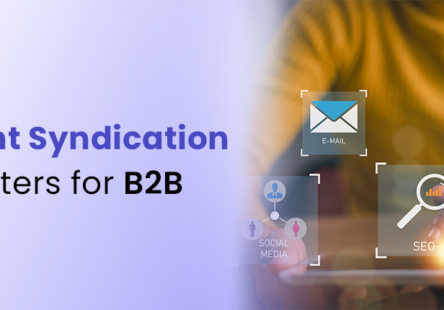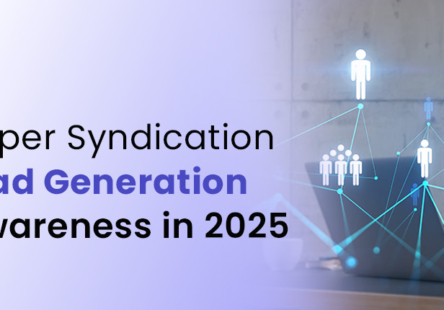B2B content syndication has evolved beyond simply distributing content across multiple platforms. The integration of Artificial Intelligence (AI) and intent data has transformed this strategy. Marketers can now reach the right audience at the right time with highly relevant content.
AI-driven automation combined with the deep insights of intent data have made content syndication more efficient, personalized, and results-driven than ever before.
This blog explores how AI and intent data are reshaping B2B content syndication and how businesses can leverage these technologies for maximum impact.
Understanding AI and Intent Data in B2B Marketing
Artificial Intelligence (AI) enables marketers to analyze vast amounts of data, automate decision-making, and optimize content strategies. Machine learning algorithms identify patterns, predict outcomes, and personalize engagement based on behavioral insights.
Intent Data tracks online behaviors such as website visits, content downloads, and keyword searches to identify prospects’ interests and buying intent. This data helps B2B marketers understand who is actively researching their products or services and when they are likely to convert.
The Role of AI in Transforming Content Syndication
AI is revolutionizing content syndication in several ways:
1. Enhanced Targeting and Personalization
AI-powered algorithms analyze user behavior and preferences to deliver hyper-personalized content to the right audience at the optimal time. According to Demand Gen Report, AI-driven personalization has significantly improved content syndication outcomes.
2. Automated Content Distribution
AI optimizes content delivery across multiple channels, determining the best platforms and times for maximum engagement. This automation saves resources and enhances campaign efficiency.
3. Predictive Analytics for Smarter Strategy
Predictive models forecast audience behavior, enabling marketers to plan and adjust content strategies proactively.

The Impact of Intent Data on Content Syndication
Intent data provides deep insights into buyer readiness, allowing businesses to refine their syndication strategies:
1. Lead Prioritization with Intent Data
By analyzing signals such as content consumption, keyword searches, and engagement levels, marketers can identify high-intent leads and pass them to sales teams for quicker conversion.
2. Content Customization for Higher Engagement
Tailoring content based on prospect intent ensures relevance, increasing engagement rates and shortening the sales cycle. According to Only-B2B, 52% of marketers use intent data for tailored content.
3. Increased Efficiency in Resource Allocation
Intent data helps marketers focus their efforts on leads that show genuine interest, optimizing ROI and reducing wasted efforts.
Integrating AI and Intent Data into Your Syndication Strategy
To successfully integrate AI and intent data into content syndication, businesses should:
1. Collect and Manage Data Effectively
Accurate data is the foundation of AI and intent-driven syndication. Businesses should use AI-powered tools to track audience behavior, analyze intent signals, and centralize data from different sources. Real-time data collection keeps marketing teams updated, helping them refine their strategies as needed.
2. Personalize Content with AI
AI automates personalization by analyzing user interactions and adapting content accordingly. Businesses should use machine learning models to adjust email campaigns, digital ads, and syndicated content. This approach helps prospects receive content that aligns with their interests and stage in the buying journey.
3. Improve Collaboration Across Teams
Marketing, sales, and data teams must work together for AI and intent data to be effective. Siloed operations slow progress. A shared data system allows teams to act on intent-driven insights quickly. Sales teams can focus on high-intent leads, while marketing fine-tunes content strategies based on real-time engagement.
4. Track and Adjust Performance
AI and intent-driven syndication require ongoing monitoring. Businesses should use AI analytics tools to measure engagement, content effectiveness, and lead movement. Regular A/B testing helps identify what content performs best. Data-backed insights should guide adjustments to make syndication efforts more impactful.
Benefits of Using AI and Intent Data in B2B Content Syndication
1. Increased Efficiency:
AI automation saves time and effort by eliminating manual processes. Marketers can focus on strategy instead of repetitive tasks.
2. Better Audience Targeting:
Intent data ensures content reaches the right people at the right time, improving engagement and reducing wasted outreach.
3. Higher Lead Quality:
AI helps filter out unqualified leads, ensuring that only high-intent prospects move through the funnel. This improves conversion rates and shortens the sales cycle.
4. Improved ROI:
AI and intent data reduce wasted marketing spend by prioritizing high-intent prospects and optimizing content distribution.
5. Enhanced Personalization:
AI enables hyper-personalization by analyzing real-time user behavior, allowing marketers to tailor content that resonates with individual prospects.
6. Optimized Content Performance:
AI tools analyze engagement patterns and provide real-time optimization suggestions, helping marketers continuously improve their content syndication strategy.
7. Scalability:
AI-driven content syndication is scalable, allowing businesses to expand their outreach without significantly increasing workload or costs.
In Conclusion:
AI and intent data have transformed B2B content syndication. Businesses that use these technologies see higher engagement, better lead quality, and improved ROI.
By leveraging AI-powered automation, predictive analytics, and real-time intent signals, marketers can deliver content to the right audience at the perfect moment. This enhances the customer experience and makes marketing efforts more efficient.
As B2B competition grows, businesses that fail to adopt AI-driven syndication will struggle. The ability to automate, personalize, and optimize content distribution is a game-changer. Companies that embrace these innovations will establish authority, build stronger relationships, and drive conversions.
Frequently Asked Questions (FAQs)
What is the role of AI in B2B content syndication?
AI enhances B2B content syndication by:
- Analyzing large datasets to identify patterns and user behavior
- Automating content distribution across optimal platforms and times
- Personalizing content for specific audiences
- Predicting engagement and improving campaign performance through analytics
What is intent data and how does it support syndication efforts?
Intent data tracks buyer behavior (searches, downloads, site visits) to identify when a prospect is actively researching a product or service. In syndication, it helps:
- Prioritize high-intent leads
- Customize content to match buyer interest
- Improve lead conversion by focusing on prospects with actual buying signals
How do AI and intent data work together in content syndication?
Together, they allow marketers to:
- Automate delivery of personalized content based on real-time behavior
- Predict when and where to syndicate for maximum impact
- Filter out low-quality leads, focusing only on those with active intent
- Adjust strategies quickly based on AI-driven engagement data
What are the main benefits of using AI and intent data in B2B syndication?
- Efficiency: Reduces manual work through automation
- Targeting: Reaches in-market buyers more accurately
- Lead Quality: Filters out noise, prioritizes high-intent prospects
- ROI: Lowers cost per acquisition by avoiding wasted outreach
- Personalization: Serves content tailored to buyer needs
- Scalability: Enables expansion without growing internal workload
How can businesses get started with AI-powered content syndication?
- Use AI-enabled tools to centralize and analyze audience behavior
- Embed intent data platforms like Bombora or 6sense
- Collaborate across teams (sales, marketing, data) for unified execution
- Deploy machine learning models for content adaptation
- Track performance using AI analytics and A/B testing
What challenges do companies face when implementing AI and intent data?
- Data quality and management: Poor or fragmented data can mislead targeting
- Tech integration: Requires aligning CRMs, MAPs, and AI tools
- Team collaboration: Siloed departments may hinder real-time optimization
- Privacy and compliance: Using third-party data must meet regulatory standards
How does AI help with content personalization in syndication?
AI uses behavioral signals like page views, clicks, and email engagement to:
- Adjust CTAs and messaging dynamically
- Serve the right content format (e.g., eBooks, webinars, articles) per user
- Align delivery timing based on buyer journey stage
How do intent signals enhance lead prioritization?
By tracking real-time activities such as:
- High-frequency searches for solution-specific keywords
- Repeated visits to product pages or pricing info
- Content engagement on review platforms or forums
These signals suggest readiness to buy, helping teams focus on the most promising leads.
What types of metrics should be monitored in AI + intent-driven syndication?
- Lead quality scores
- Engagement rates (time on content, clicks, replies)
- Conversion rates from MQL to SQL
- Pipeline velocity and influenced revenue
- ROI and cost per lead (CPL)
Is AI-powered syndication suitable for small and mid-sized B2B firms?
Yes. Even mid-sized businesses benefit from automation, smarter targeting, and content personalization. Many affordable tools offer AI and intent-data capabilities at scale, helping these firms compete more effectively without large teams.




